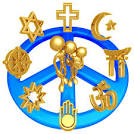Are you interested in the neurosciences? Then let us explore a little quantum mechanics.
There are many parallels. I am not a physicist and quantum mechanics can be very complex or very simple. I will take the simple route.
First, forget everything you have read or been taught about God because God is allegory. Everything you have learned from religion is allegory. We are allegory!!! Second, there is nothing new in quantum mechanics, it was knowledge common to the ancient Hebrews and the Egyptians and it has been passed down through metaphor and symbolism, originally depicted in the workings of the Sun, stars and universe; astronomy and astrology.
Quantum mechanics describes the universe.
The universe is made up of matter and energy. In quantum mechanics this is known as particles and waves. There are some particles we know of and others still to be discovered. The two main particles are the Boson and the Fermions. Light, is the creator of the universe, an electromagnetic phenomenon, it is the most familiar form of Boson.
Fermions are present in the most common substances of our world. Fermions are made up of electrons, protons and neutrons, or the key substances we call atoms.
Fermions can in turn be subdivided into two groups, leptons, invisible particles, which include nutrinos, particles that play a key role in the universe and are likely left over from the Big Bang. The other group of Fermions are the hedrons. The hedrons are made up of smaller units of particles, which we call quarks.
Hedrons are assembled from three quarks and we call these baryons. The baryons are key to Creation. All atomic nuclei are composed of baryons. These are better referred to as nuclear matter as many of the baryons disappear as soon as they are created.
The most important thing to remember is this, in our universe most of the substances are made up of Fermions, electrons, protons and neutrons, with the exception of a subclass called dark matter, this is made up of the “missing” mass of the universe, (galaxies should have more mass than they do in order to retain their shape).
In order to understand the relevance of quantum mechanics we need to probe the processes of Creation and the earliest forms of particle behaviour, which will include one other property known as antimatter.
In the theory of relativity, the total mass of a particle is not constant, it includes the mass associated with its energy and motion, Einstein’s equation E = mc2. (This has also been the topic of an acclaimed disambiguation and the uncertainty principle).
Leaving the challenges aside, the scientist Paul Dirac in 1933 discovered the antiparticle, one that moves in reverse direction. While it appeared impossible to have particles moving in opposite directions at the same time, it was discovered that all Fermions have a corresponding antiparticle. For example, the antiparticle of an electron is called a positron and an antiparticle of each type of quark is called an antiquark.
Matter and antimatter are identical except that they have opposite charges. When particles of the opposite type come into contact with each other they annihilate each other turning into a burst of light – two photons – whose combined energy is related to the total mass of the two particles. Einstein’s equation E = mc2 .
The knowledge of our world is that it contains fewer than one hundred kinds of atoms, that is normal matter, which in turn constitutes twenty-nine fundamental particles and their variants. However, the vast majority of matter in the universe remains invisible. We can only glimpse its existence in the motions of the universe. Much like consciousness, we know we are conscious human beings, but we cannot see consciousness or know for sure where it originates from.
The scientific evidence suggests that most of the matter in the universe is dark matter, something we know little about. We know of its existence when it becomes slightly visible in the halos of galaxies, stars and nebulae heated directly or indirectly by other stars.
To be clear, the world we experience is one of light and atoms, composed of Bosons and Fermions. These are characterized by their tendency to aggregate and being either indistinguishable or having the need to segregate and thus, becoming individually identifiable.
It has taken thousands of years to get this small amount of information. Imagine what is missing from the equations.
What have we missed?
In Jewish mysticism the universal forms and their relationships derive from a common source God’s spoken Word as it was recorded in Genesis. The scientific picture when deconstructed is not very different. In both versions there are particles and forces.
We know that the nature of particles sees them interacting with one another without coming into actual contact. In science this does not appear to be a strange phenomenon, but when we relate it to religions or the existence of a God or mystical energy, doubts are raised. What is this invisible force? How can we know it when it is invisible?
The historical context of this knowledge is important. In ancient times, the world’s rulers gathered much of their strength and kudos through their approval of pagan gods and goddesses (their alter-ego). In some cases rulers were the perceived to be gods. The allocation of the supreme gods made sense to the agrarian populations because they resonated with nature.
However, the vision of nature stopped at the borders of our planet. What was in the heavens was a mystery, but it was not a mystery to all. It was in fact, a carefully guarded secret.
Knowledge is power said the modern philosopher Michel Foucault and in many cases those with knowledge of the universe threatened the powerful and established elites.
The real scientific meanings hidden in the religious texts were highly protected. Indeed, Creation, Revelation and Redemption, were threatening concepts to those who ruled. They were deemed the prerogative of rulers, not some heavenly force.
Before the Dark Ages the ancients did not see the Earth as flat. Rather, they understood how gravity deforms space into a grid, from this the Earth would have appeared flat. Astrologers drew their patterns from the stars and attributed mathematical equations to their unique shapes and curves.
In modern times we have devised the notion of fields to explain matter and energy. These fields can be visualized as lines of force that emanate from particles. School children learn this by putting a magnet under a table containing iron filings. The magnet moves the filings in any direction as long as someone is guiding the magnet. So what guides the magnetism of the universe? Why are particles appearing and disappearing?
Given the relation between forces and particles, especially during the time of Creation, one might suggest that there is a grand and unified theory for us to relate to. This has its own natural appeal. Hence, we have created religions and put aside the laws of physics (the separation of science and religion) and we have carried this into our modern age.
The laws of physics describe how particles behave and the need for a supreme force to govern them. This should be philosophically reassuring to atheists, while raising the miraculous value of God (a unified force) to spiritual believers. God was only one name attributed to this force, there were many. To the Hebrews the name was an unspoken word meaning breath.
There is much we still do not know, for example, String Theory starts with the presumption that particles may not be zero dimensional. Rather, particles are more like waves or vibrating particles dancing along a string.
Further, there may be more than one dimension and perhaps even a microwave background that ensures a harmonious cosmic interrelationship. We might even be bold enough to describe this as a cosmic consciousness.
The deep symmetry of science was recognized by all the mystics. In particular, it was advanced by the Kabbalists in the notion that the world was created by one supreme force. The idea was expanded to include a spirit or soul, which today underscores mystical spiritual beliefs.
The idea is not so far fetched as today we are grappling with the same questions over human consciousness. Where is consciousness located in the human brain.? We do not have the answer to this question. We may never have it because we are looking in the wrong place.
It is very likely, if we are to believe the ancient texts, that there is only one consciousness and we all experience a small part of it.


